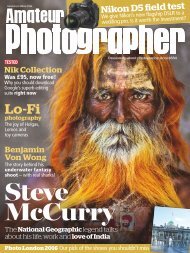You also want an ePaper? Increase the reach of your titles
YUMPU automatically turns print PDFs into web optimized ePapers that Google loves.
A dark answer<br />
Dark matter existed as a concept, first proposed by astronomers<br />
like Jan Oort in 1932 and Fritz Zwicky in 1933, who also noticed<br />
discrepancies in how much mass astronomers could see and how<br />
much physics implied should be present. But few paid their work<br />
any attention, writing their research off as little more than cosmological<br />
oddities. And no one had bagged such solid evidence<br />
of it before. And because no one had predicted what dark matter’s<br />
existence might mean for galaxy dynamics, Rubin and Ford initially<br />
didn’t recognize the meaning of their flat rotation curves.<br />
“Months were taken up in trying to understand what I was<br />
looking at,” Rubin told journalist Maria Popova. “One day I just<br />
decided that I had to understand what this complexity was that I<br />
was looking at, and I made sketches on a piece of paper, and suddenly<br />
I understood it all.”<br />
If a halo of dark matter graced each galaxy, she realized, the<br />
mass would be spread throughout the galaxy, rather than concentrating<br />
in the center. The gravitational force — and the orbital<br />
speed — would be similar throughout.<br />
Rubin and Ford had discovered the unseeable stuff that influences<br />
not only how galaxies move, but how the universe came<br />
to be and what it will become. “My entire education highlighted<br />
how fundamental dark matter is to our current understanding of<br />
astrophysics,” says Levesque, “and it’s hard for me to imagine the<br />
field or the universe without it.”<br />
Within a few years of the M31 observations, physicists like<br />
Jeremiah Ostriker and James Peebles provided the theoretical<br />
framework to support what Rubin and Ford had already shown, and<br />
dark matter settled firmly into its celebrated place in the universe.<br />
In more recent years, the Planck satellite measured the dark<br />
matter content of the universe by looking at the cosmic microwave<br />
background, the radiation left over from the Big Bang. The<br />
clumps of matter in this baby picture of the universe evolved into<br />
the galaxy superclusters we see today, and it was dark matter that<br />
clumped first and drew the regular matter together.<br />
Data from galaxy clusters now also confirms dark matter and<br />
helps scientists measure how much of it exists within a given<br />
group — a modern echo of Zwicky’s almost forgotten work. When<br />
light from more distant sources passes near a cluster, the gravity<br />
— from the cluster’s huge mass — bends the light like a lens.<br />
The amount of bending can reveal the amount of dark matter.<br />
Rubin measures spectra at the Carnegie Institution’s Department of<br />
Terrestrial Magnetism. It was such measurements that revealed to Rubin<br />
that the outer regions of galaxies rotated as fast as their inner regions —<br />
indicating some huge amount of missing mass that would later be realized<br />
as dark matter. AIP/EMILIO SEGRE VISUAL ARCHIVES<br />
Rubin continued to work at the Carnegie Institution’s Department<br />
of Terrestrial Magnetism until recently, still fascinated by galaxies<br />
and studying how they move in the universe. AIP/EMILIO SEGRE VISUAL ARCHIVES<br />
No matter which way or where scientists measure Rubin’s discovery,<br />
it’s huge.<br />
And while no one knows what all the dark matter is, scientists<br />
have discovered that some small fraction of it is made of<br />
neutrinos — tiny, fast-moving particles that don’t really interact<br />
with normal matter. Measurements from the cosmic microwave<br />
background, like those being taken by experiments called<br />
POLARBEAR in Chile and BICEP2 and BICEP3 in Antarctica,<br />
will help pin down how many neutrinos are streaming through<br />
the universe and how much of the dark matter they make up.<br />
Some setups, like the Gran Sasso National Laboratory in Italy<br />
and the Deep Underground Science and Engineering Laboratory<br />
in South Dakota, are trying to detect dark matter particles<br />
directly, when they crash into atoms in cryogenically cooled<br />
tanks filled with liquefied noble gases. So far, they haven’t managed<br />
to capture a dark matter particle in action. But researchers<br />
are taking dark matter — whatever it is — into account when<br />
they think about how the universe evolves.<br />
The Nobel committee may overlook Rubin, passing by her as<br />
if they can’t see what all of astrophysics feels. But that won’t hurt<br />
her legacy, says Levesque: It will hurt the legacy of the Nobel<br />
itself. “It would then permanently lack any recognition of such<br />
groundbreaking work,” Levesque says.<br />
Rubin herself has never spoken about how she deserves a<br />
Nobel Prize. She simply continued her scientific work until<br />
recently, all the while influencing the origins, evolutions, and<br />
fates of other scientists. “If they didn’t get a job or they didn’t get<br />
a paper published, she would cheer people up,” says Bahcall. “She<br />
kept telling her story about how there are ups and downs and you<br />
stick with it and keep doing what you love doing.”<br />
Rubin, herself, loves trying to understand the universe, and<br />
in doing so, she has changed everyone’s understanding of it.<br />
That carries more weight than some medal from Sweden. But let<br />
Sweden recognize that for what it is: worthy of a prize.<br />
WWW.ASTRONOMY.COM 31






